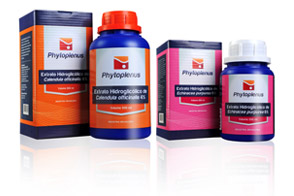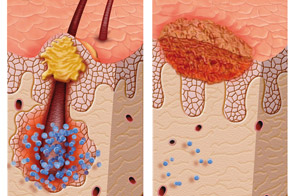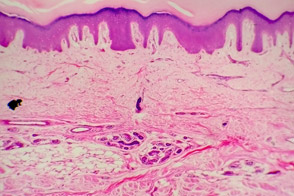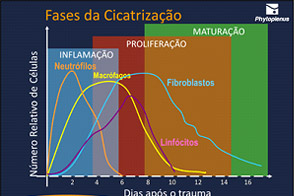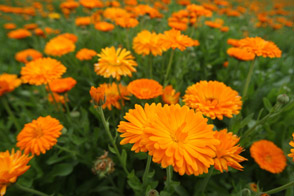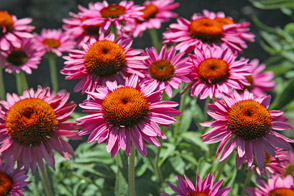The bioactive therapeutic proposals
Wound Healing
After an injury, the skin starts an immediate process of repairing of the affected region. This process includes three phases:
1. Inflammatory Phase: fibrin and insoluble proteins – essential part of the blood clots – are formed and connect to the exposed collagen to promote blood flow interruption – a process called hemostasis.
Inflammatory cells called neutrophils emerge in the early hours of the injury to annihilate the microbes, thus limiting the infection of the lesion. Subsequently, macrophages cells arrive to destroy the remaining microbes and help signal the proliferation of fibroblasts, the cells that are responsible for collagen formation.
Macrophages play an important part in coordinating the healing process because they perform various functions in the tissue such as: (a) debridement, by enzymatical phagocytosis, (b) antimicrobial action, by releasing nitric oxide and oxygen radicals, (c) cell activation, by releasing growth factors, cytokines and fibronectins (d) synthesis and regulation of the protein matrix, by releasing growth factors (PDGF, TGF-β, EGF), regulatory cytokines (TNF-α, IL-1, IFN-γ) enzymes (collagenase and arginase, and prostaglandins (PGE 2), (e) promotion of angiogenesis, by releasing endothelial growth factors (VEGF, bFGF) fibroblast activation and cytokines (TNF-α).
2. Proliferative Phase: Fibroblasts are stimulated to synthesize collagen and form granulation tissue. This new tissue is fueled by the growth of new blood vessels through a process called angiogenesis.
3. Remodeling phase: This phase is characterized by the re-epithelialization that reconstructs the tissue. The new layer covers the injured skin and allows the repair process to continue. At this stage, the new tissue is put and practically restores the whole condition of the original tissue.
In chronic injuries, the healing process remains in the inflammatory phase for a long time or indefinitely. The immunocompetent cells, which are responsible not only for the coordination of cellular and biochemical events, but also for the resolution of wound healing, do not become fully functional and wildly release cytotoxic substances, which are normally used to fight pathogens and worsen of the lesion.
When an injury cannot fully escalate into re-epithelialization, external support is needed to facilitate the biochemical and cellular processes that are impaired. In this sense, external supports, such as topical medications, bandages, dressings and others, must show characteristics such as: (a) preservation of cellular activity at each stage, (b) constant maintenance of an appropriate physiological condition on the lesion, (c) promotion of microcirculation and satisfactory gas exchange, (d) inhibition of the extracellular matrix disruption, and (e) promotion of the synthesis of tissue growth factors. When a topical medication or a dressing does not enable on of these processes, the wound healing is compromised and results in a chronic lesion.
Some dressings that occlude the lesion and squeeze the peripheral circulation, stopping the exchange of oxygen in the healing tissue, are responsible for the failure of the treatment, and also stimulate the spreading of pathogens such as bacteria and fungi. The lack of oxygen in the tissue impairs the action of the macrophages and other important cells in the healing process. Other topical medications that have oxidant components in their formulations seriously harm the tissue repairing process, for the cytotoxic acts over the immunocompetent cells such as macrophages, which play a fundamental role on the coordination of the healing processes.
Last but not least, we ought to highlight that the processes that involve the repairing of a skin lesion must be precisely controlled, otherwise one may get sidetracked with damaging results on the tissue. The exuberant keloid scar tissue is an example of inadequate control of the repairing process that occurs in response to a skin lesion. Chronic lesions, associated with diseases such as diabetes and vascular and/or arterial deficiency, are also results of an inefficient repairing process of the organism on affected tissue. In cases where the healing process is ineffective, there is a need for an external support, such as dressings and/or topical medications that help the debridement, fight infections and stimulate vascular and epithelial cell proliferation, preserving the populations of the immunocompetent cells that are responsible for coordinating various tissue repairing events.
Bioactive compounds preparations
Calendula
Phytoplenus Bioativos S.A. developed a technology that effectively isolates various biomolecules from the secondary metabolism of the plant Calendula officinalis L., such as saponosidic triterpenoid monoesters faradiols, calenduladiols and arnidiols. These bioactive compounds of therapeutic interest are processed into a high quality extract used in clinical dermatological preparations through the Phytoplenus Technology. The extract produced by the Phytoplenus technology based on Calendula officinalis L. promotes efficient wound healing in all aspects because it meets all of the features mentioned above.
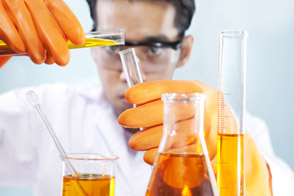
The various bioactive compounds present in the extract – mainly triterpenoid monoesters faradiols – are immune modulators that help biochemical and cellular events follow their courses, thus preventing an exacerbated release of pro-inflammatory mediators such as prostaglandins and other eicosanoids, which usually cause inflammation and hyperalgesic pain. Other bioactive compounds present in this Phytoplenus extract are glycoside flavonoids of quercetin and isorramnectin, which are important because they reduce capillary fragility, and therefore aid in the angiogenesis and the growth of the healing tissue.
Echinacea
Among these different and effective bioactive compounds extracts generated by this technology, Phytoplenus produces an extract with immunostimulating properties from the plant Echinacea purpurea (L.) Moench. The bioactive compounds of Echinacea purpurea are represented by Alkamides derivatives of decanoic and undecanoic acids, and phenolic derivatives such as caftaric, chlorogenic, and chicoric acid.
The extract of Echinacea purpurea produced by Phytoplenus has immunostimulatory effects on the immune system and acts functionally both in a non-specific and in a specific way. Non-specific effects include increased proliferation of macrophages and phagocytosis, as well as secretion of interferon, tumor necrosis factor and interleukin-1 (in vitro and in vivo). The specific immune responses include the activation of alternative pathway complement components through high levels/activity of T lymphocytes and natural killer cells (NK). It is believed that Echinacea purpurea is the vegetable specie that has the strongest immunostimulation power, which depends on the dosage and on the frequency of administration. It has been observed that taking Echinacea purpurea for seven days significantly increases the basal levels of lymphocytes, monocytes and neutrophils, as well as CD16 and natural killer cells (NK).
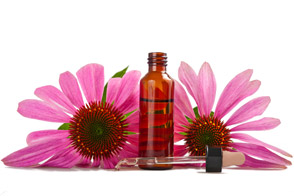
The extract of Echinacea purpurea produced by Phytoplenus Technology promotes an effective reduction of dermal lesions through the immunostimulation of macrophages and other immunocompetent cells that important in the healing process. It also has an adjuvant action against opportunistic viral infections, resulting in an efficient tissue repair. The various bioactive compounds present in the extract – especially alkamides derived from decanoic and undecanoic acids, and phenolic acid derivatives such as chlorogenic, caftaric and chicoric acids and polysaccharides – are immunological and healing boosters, which help the cellular and biochemical events to follow their normal course, thus preventing an exacerbated release of pro-inflammatory mediators such as prostaglandins and other eicosanoids, which usually cause inflammation and hyperalgesic pain.
In this context, the Echinacea purpurea extract produced by Phytoplenus Technology gathers all the functions mentioned above on the process of topical immunomodulation and tissue repair in a single extract, presenting a special and more effective preparation in comparison to conventional products.
Other bioactive extracts being developed
The demands of the target consumer, the competition and the quick development of the production technologies stimulate Phytoplenus to continuously invest in research and development to ensure new products so as to keep a competitive position.
In this regard, Phytoplenus invests in researches and in the development of its products, using its technological process to create products that shall be used to treat skin diseases that can’t be treated with the products mentioned above, as well as to evaluate new conceptions for the existing products.
Thus, Phytoplenus’ main goal is the continuous development of new products in response to market needs. Due to the high effectiveness of the products generated by the company’s technological process – as it’s been observed in skin lesions clinical studies that used the preparations mentioned above, as well as because of the wide range of skin pathologies – Phytoplenus initially focused its research on the treatment of skin disorders, including the treatment of keloids generated by surgeries, thrushes, ringworms, eczemas, leprosy wounds, zooparasitoses, acne, herpes zoster, bruises, contusions, sprains, hemorrhoids, ophthalmic wounds, oral lesions and gingivitis.
For that matter, Phytoplenus will seek to develop products for treating gastric ulcers, gastritis, diseases related to immunomodulation, prostatic hyperplasia, hyperglycemia, hemorrhoids, venous capillary fragility, and other pathologies.
It should be noted that the indications given are not exhaustive, so there may be new applications, as well as other pathologies that out to be evaluated.
Compounding Pharmaceutical Ingredients
PHYTOPLENUS’ PRODUCTS QUALITY AND CHARACTERISTICS
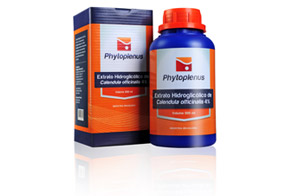
PHYTOPLENUS CALENDULA EXTRACT
TECHNICAL INFORMATION FOR PHYTOPLENUS CALENDULA EXTRACT
|
| Class |
COMPONENT OF PHYTO-THERAPEUTIC MEDICATION |
| Official Botanical Name |
Calendula officinalis L. |
| Popular Name |
Calendula, Marigold |
| Family |
Asteraceae |
| Part of Plant Used |
Flower |
| Commercial Name |
Hydroglycolic Extract of Calendula officinalis 4% |
| Manufactured By |
Phytoplenus Bioativos S.A.
Rua Wanda dos Santos Mullmann, 1501
CEP 83323-123 — Pinhais — PR
CNPJ/MF Nº 10.704.205/0001-01
Information:
Phone/Fax: (41) 3667-1717
E-mail: info@phytoplenus.com
Site: www.phytoplenus.com
Made in Brazil |
| Responsible Technician |
Estevan Bruginski / CRF-PR Nº 23447 |
| Form |
Liquid |
| Packaging |
High-density polyethylene (HDPE) bottle with sealable cap in 250 ml, 500 ml, and 1000 ml sizes. |
| Composition |
Calendula officinalis L. 4%
Excipients: BHT (Butylated hydroxytoluene), ethanol, polyethylene glycol, purified water. |
| Indications |
Extract for dermic compounded preparations used as anti-inflammatory agent for healing skin and mucosae lesions (BLUMENTHAL et al., 1998; ESCOP, 1997). |
| Instructions for Compounding Medications Based on Phytoplenus Hydroglycolic Extract of Calendula officinalis 4% da Phytoplenus |
Phytoplenus Hydroglycolic Extract of Calendula officinalis 4% must be prepared at compounding pharmacies which had been accredited and certified by Phytoplenus in accordance with current health regulations.
For greater efficacy of the preparations, it is recommended that compounded formulations made from the Phytoplenus Hydroglycolic Extract of Calendula officinalis 4% be diluted with purified water to a concentration of 2%. |
WARNING!
Phytoplenus Hydroglycolic Extract of Calendula officinalis 4% (PSA-EPD) is a pharmaceutical ingredient, and not a medication. The medication made of Phytoplenus Extract can only be obtained through a doctor’s prescription at pharmacies certified by Phytoplenus, as stated above.
Warning: Cannot modify header information - headers already sent by (output started at /home2/auspex22/phytoplenus.com.br/produtos.php:271) in
/home2/auspex22/phytoplenus.com.br/common/functions.php on line
24
INFORMATION ABOUT TOPICAL COMPOUNDED FORMULATIONS USING PHYTOPLENUS HYDROGLYCOLIC EXTRACT OF Calendula officinalis L. 4%
|
| CHARACTERISTICS |
Advantages |
| CONTENT |
It is a natural product, non-toxic, non-polluting, biodegradable, perfectly connected with the expectations of modern society for products that are healthier and focused on quality life. |
| WOUND HEALING PERFORMANCE |
It provides an exceptional and uniform wound healing, resulting in inconspicuous scars with great appearance, without excessive fibrous tissue or keloids. |
| HEALING TIME |
It reduces the healing time greatly, especially in chronic lesions. |
| PAIN CONTROL |
It promptly decreases sensitivity to pain or itching in the injury area. |
| PRICE |
It fits the herbal medicines price table and therefore is extremely accessible to all socioeconomic classes. |
| WOUND APPEARENCE AND CLEANING |
It does not leave any residue in the injured area, promoting a natural debridement of the devitalized tissue. |
| PHARMACEUTICAL FORM |
It is a liquid spray solution that significantly makes the treatment simpler and doesn’t have the numerous use and care restrictions if compared to most competing products that are only available in solid and semi-solid shapes. |
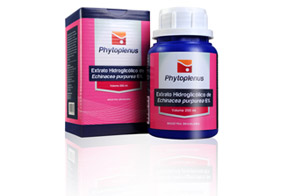
Warning: Cannot modify header information - headers already sent by (output started at /home2/auspex22/phytoplenus.com.br/produtos.php:271) in
/home2/auspex22/phytoplenus.com.br/common/functions.php on line
24
PHYTOPLENUS ECHINACEA EXTRACT
TECHNICAL INFORMATION FOR PHYTOPLENUS ECHINACEA EXTRACT
|
| Class |
COMPONENT OF PHYTO-THERAPEUTIC MEDICATION |
| Official Botanical Name |
Echinacea purpurea (L.) Moench |
| Popular Name |
Echinacea |
| Family |
Asteraceae |
| Part of Plant Used |
Flowers and aerial portions |
| Commercial Name |
Extrato Hidroglicólico de Echinacea purpurea 6% |
| Manufactured by |
Phytoplenus Bioativos S.A.
Rua Wanda dos Santos Mullmann, 1501
CEP 83323-123 — Pinhais — PR
CNPJ/MF Nº 10.704.205/0001-01
Information:
hone/Fax: (41) 3667-1717
E-mail: info@phytoplenus.com
Site: www.phytoplenus.com
Made in Brazil |
| Responsible Technician |
Estevan Bruginski / CRF-PR Nº 23447 |
| Form |
Liquid |
| Packaging |
High-density polyethylene (HDPE) bottle with sealable lid in 250 ml, 500 ml, and 1000 ml sizes. |
| Composition |
Echinacea purpurea (L.) Moench 6%
Excipients: BHT (Butylated hydroxytoluene), ethanol, citric acid, polyethylene glycol, purified water. |
| Indications |
Extract for dermic compounded preparations used as anti-inflammatory and immune stimulation agent for healing skin and mucosae lesions. |
| Instructions for Compounding Medications Based on Phytoplenus Hydroglycolic Extract of Echinacea purpurea 6% |
Phytoplenus Hydroglycolic Extract of Echinacea purpurea 6% must be prepared at compounding pharmacies which is accredited and certified by Phytoplenus in accordance with current health regulations.
For greater efficacy of the preparations, it is recommended that compounded formulations made from Phytoplenus Hydroglycolic Extract of Echinacea purpurea 6% be diluted with purified water to a concentration of 3%. |
WARNING!
Phytoplenus Hydroglycolic Extract of Echinacea purpurea 6% (PSA-EPV)is a pharmaceutical ingredient, and not a medication. The medication made of Phytoplenus Extract can only be obtained through a doctor’s prescription at pharmacies certified by Phytoplenus, as stated above.
Warning: Cannot modify header information - headers already sent by (output started at /home2/auspex22/phytoplenus.com.br/produtos.php:271) in
/home2/auspex22/phytoplenus.com.br/common/functions.php on line
24
INFORMATION ABOUT TOPICAL COMPOUNDED FORMULATIONS USING PHYTOPLENUS HYDROGLYCOLIC EXTRACT OF Echinacea purpurea (L.) Moench 6%
|
| CHARACTERISTICS |
Advantages |
| CONTENT |
It is a natural product, non-toxic, non-polluting, biodegradable, perfectly connected with the expectations of modern society for products that are healthier and focused on quality. |
| WOUND HEALING PERFORMANCE |
It provides an exceptional and uniform wound healing, resulting in inconspicuous scars with great appearance, without excessive fibrous tissue. |
| HEALING TIME |
It decreases the healing time greatly, especially in acute lesions caused by HSV. |
| PAIN CONTROL |
It reduces pain or itching in the damaged area, caused by the formation of herpes pustule and the inflammation of the injured area, providing greater comfort for patient. |
| PRICE |
It fits the herbal medicines price table and therefore is extremely accessible to all socioeconomic classes. |
| WOUND APPEARENCE AND CLEANING |
It does not leave any residue in the injured area, unlike most other products used to treat HSV, which, for being ointments, creams and gels, invariably leave visible residues on the lesion area. Aesthetically speaking, this characteristic is appealing to the patient. For that matter, Echinacea purpurea 6% hydro-glycolic extract liquid preparations is adhered wholly and uniformly by the damaged tissue, which creates a more visually discrete appearance, and results in a greater acceptability of the medicine. |
| PHARMACEUTICAL FORM |
It is a liquid spray solution that significantly makes the treatment simpler and doesn’t have the numerous use and care restrictions if compared to most competing products that are only available in solid and semi-solid shapes. |
